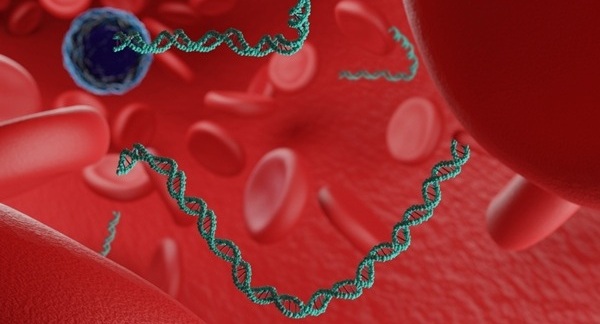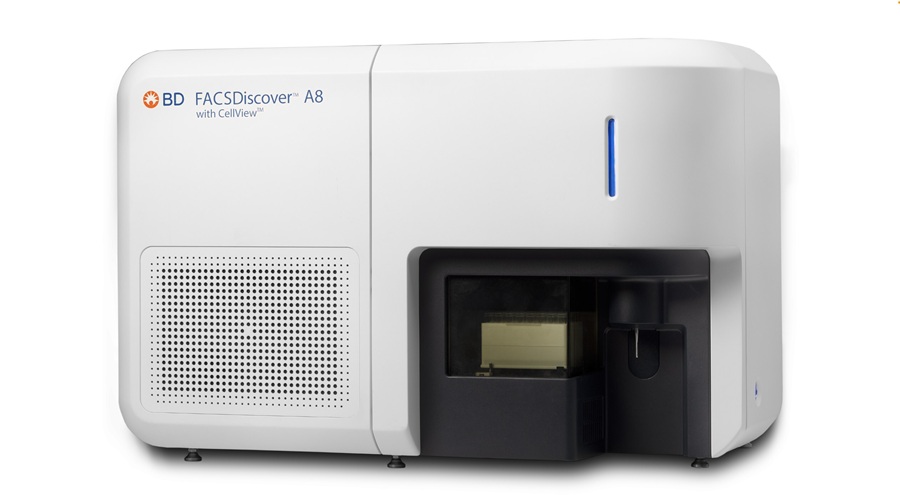A Novel Liquid Biopsy Technique for Brain Tumor Diagnosis
|
By LabMedica International staff writers Posted on 27 Oct 2020 |

Image: Digital droplet PCR (ddPCR): schematic showing oil droplets containing fluorescent PCR target molecules (Photo courtesy of Wikimedia Commons)
A minimally invasive liquid biopsy technique enables diagnosis of glioma, the most common type of brain tumor, by PCR analysis of an easily obtained blood plasma sample.
Detection of TERT (Telomerase reverse transcriptase) promoter mutations (C228T, C250T) in circulating cell free DNA (cfDNA) has been successful for some systemic cancers but has not been demonstrated in gliomas, despite the high prevalence of these mutations in glioma tissue (they are in more than 60% of all gliomas and in 80% of all high-grade gliomas, the most aggressive and life-threatening type). The liquid biopsy approach for brain tumors is complicated, as brain tumor DNA is shed into the bloodstream at much lower levels than that of any other type of tumors.
To improve this situation, investigators at Massachusetts General Hospital (Boston, USA) developed a novel digital droplet PCR assay that incorporated features to improve sensitivity and allowed for the simultaneous detection and longitudinal monitoring of two TERT promoter mutations (C228T and C250T) in cfDNA from the plasma of glioma patients.
Droplet digital PCR (ddPCR) is a method of dPCR in which a 20 microliter sample reaction including assay primers and either Taqman probes or an intercalating dye, is divided into about 20,000 nanoliter-sized oil droplets through a water-oil emulsion technique, thermocycled to endpoint in a 96-well PCR plate, and fluorescence amplitude read for all droplets in each sample well in a droplet flow cytometer.
Results revealed that in baseline performance in tumor tissue, the assay had perfect concordance with an independently performed clinical pathology laboratory assessment of TERT promoter mutations in the same tumor samples. Extending to matched plasma samples, the investigators detected TERT mutations in both discovery and blinded multi-institution validation cohorts with an overall sensitivity of 62.5% and a specificity of 90% compared to the gold standard tumor tissue-based detection of TERT mutations. Upon longitudinal monitoring in five patients, they reported that peripheral TERT mutant allele frequency reflected the clinical course of the disease with levels decreasing after surgical intervention and therapy and increasing with tumor progression.
"Liquid biopsy is particularly challenging in brain tumors because mutant DNA is shed into the bloodstream at much lower level than any other types of tumors," said contributing author Dr. Leonora Balaj, investigator in neurosurgery at Massachusetts General Hospital. "By “supercharging” our ddPCR assay with novel technical improvements, we showed for the first time that the most prevalent mutation in malignant gliomas can be detected in blood, opening a new landscape for detection and monitoring of the tumors. The test is easy to use, quick, and low cost, and could be performed in most laboratories. Importantly, the test can also be used to follow the course of disease."
The glioma liquid biopsy paper was published in the October 13, 2020, online edition of the journal Clinical Cancer Research.
Related Links:
Massachusetts General Hospital
Detection of TERT (Telomerase reverse transcriptase) promoter mutations (C228T, C250T) in circulating cell free DNA (cfDNA) has been successful for some systemic cancers but has not been demonstrated in gliomas, despite the high prevalence of these mutations in glioma tissue (they are in more than 60% of all gliomas and in 80% of all high-grade gliomas, the most aggressive and life-threatening type). The liquid biopsy approach for brain tumors is complicated, as brain tumor DNA is shed into the bloodstream at much lower levels than that of any other type of tumors.
To improve this situation, investigators at Massachusetts General Hospital (Boston, USA) developed a novel digital droplet PCR assay that incorporated features to improve sensitivity and allowed for the simultaneous detection and longitudinal monitoring of two TERT promoter mutations (C228T and C250T) in cfDNA from the plasma of glioma patients.
Droplet digital PCR (ddPCR) is a method of dPCR in which a 20 microliter sample reaction including assay primers and either Taqman probes or an intercalating dye, is divided into about 20,000 nanoliter-sized oil droplets through a water-oil emulsion technique, thermocycled to endpoint in a 96-well PCR plate, and fluorescence amplitude read for all droplets in each sample well in a droplet flow cytometer.
Results revealed that in baseline performance in tumor tissue, the assay had perfect concordance with an independently performed clinical pathology laboratory assessment of TERT promoter mutations in the same tumor samples. Extending to matched plasma samples, the investigators detected TERT mutations in both discovery and blinded multi-institution validation cohorts with an overall sensitivity of 62.5% and a specificity of 90% compared to the gold standard tumor tissue-based detection of TERT mutations. Upon longitudinal monitoring in five patients, they reported that peripheral TERT mutant allele frequency reflected the clinical course of the disease with levels decreasing after surgical intervention and therapy and increasing with tumor progression.
"Liquid biopsy is particularly challenging in brain tumors because mutant DNA is shed into the bloodstream at much lower level than any other types of tumors," said contributing author Dr. Leonora Balaj, investigator in neurosurgery at Massachusetts General Hospital. "By “supercharging” our ddPCR assay with novel technical improvements, we showed for the first time that the most prevalent mutation in malignant gliomas can be detected in blood, opening a new landscape for detection and monitoring of the tumors. The test is easy to use, quick, and low cost, and could be performed in most laboratories. Importantly, the test can also be used to follow the course of disease."
The glioma liquid biopsy paper was published in the October 13, 2020, online edition of the journal Clinical Cancer Research.
Related Links:
Massachusetts General Hospital
Latest Molecular Diagnostics News
- Urine Test Could Reveal Real Age and Life Span
- Genomic Test Identifies African Americans at Risk for Early Prostate Cancer Recurrence
- Blood Test Could Identify Biomarker Signature of Cerebral Malaria
- World’s First Biomarker Blood Test to Assess MS Progression
- Neuron-Derived Extracellular Vesicles Could Improve Alzheimer’s Diagnosis
- Sample Prep Instrument to Empower Decentralized PCR Testing for Tuberculosis
- Endometriosis Blood Test Could Replace Invasive Laparoscopic Diagnosis
- World's First NGS-Based Diagnostic Platform Fully Automates Sample-To-Result Process Within Single Device
- Rapid Diagnostic Breakthrough Simultaneously Detects Resistance and Virulence in Klebsiella Pneumoniae
- DNA Detection Platform Enables Real-Time Molecular Detection
- STI Molecular Test Delivers Rapid POC Results for Treatment Guidance
- Blood Biomarker Improves Early Brain Injury Prognosis After Cardiac Arrest
- Biomarkers Could Identify Patients at High Risk of Severe AKI After Major Surgery
- CLIA Test Identifies Head and Neck Cancer Recurrence from Post-Surgical Lymphatic Fluid
- New 15-Minute Hepatitis C Test Paves Way for Same-Day Treatment
- Ovarian Cancer Assay Outperforms Traditional Tests in Early Detection
Channels
Clinical Chemistry
view channel
Compact Raman Imaging System Detects Subtle Tumor Signals
Accurate cancer diagnosis often depends on labor-intensive tissue staining and expert pathological review, which can delay results and limit access to rapid screening. These conventional methods also make... Read more
Noninvasive Blood-Glucose Monitoring to Replace Finger Pricks for Diabetics
People with diabetes often need to measure their blood glucose multiple times a day, most commonly through finger-prick blood tests or implanted sensors. These methods can be painful, inconvenient, and... Read moreHematology
view channel
MRD Tests Could Predict Survival in Leukemia Patients
Acute myeloid leukemia is an aggressive blood cancer that disrupts normal blood cell production and often relapses even after intensive treatment. Clinicians currently lack early, reliable markers to predict... Read more
Platelet Activity Blood Test in Middle Age Could Identify Early Alzheimer’s Risk
Early detection of Alzheimer’s disease remains one of the biggest unmet needs in neurology, particularly because the biological changes underlying the disorder begin decades before memory symptoms appear.... Read more
Microvesicles Measurement Could Detect Vascular Injury in Sickle Cell Disease Patients
Assessing disease severity in sickle cell disease (SCD) remains challenging, especially when trying to predict hemolysis, vascular injury, and risk of complications such as vaso-occlusive crises.... Read more
ADLM’s New Coagulation Testing Guidance to Improve Care for Patients on Blood Thinners
Direct oral anticoagulants (DOACs) are one of the most common types of blood thinners. Patients take them to prevent a host of complications that could arise from blood clotting, including stroke, deep... Read moreImmunology
view channel
Ultrasensitive Liquid Biopsy Demonstrates Efficacy in Predicting Immunotherapy Response
Immunotherapy has transformed cancer treatment, but only a small proportion of patients experience lasting benefit, with response rates often remaining between 10% and 20%. Clinicians currently lack reliable... Read more
Blood Test Could Identify Colon Cancer Patients to Benefit from NSAIDs
Colon cancer remains a major cause of cancer-related illness, with many patients facing relapse even after surgery and chemotherapy. Up to 40% of people with stage III disease experience recurrence, highlighting... Read moreMicrobiology
view channel
New UTI Diagnosis Method Delivers Antibiotic Resistance Results 24 Hours Earlier
Urinary tract infections affect around 152 million people every year, making them one of the most common bacterial infections worldwide. In routine medical practice, diagnosis often relies on rapid urine... Read more
Breakthroughs in Microbial Analysis to Enhance Disease Prediction
Microorganisms shape human health, ecosystems, and the planet’s climate, yet identifying them and understanding how they are related remains a major scientific challenge. Even with modern DNA sequencing,... Read morePathology
view channel
Genetics and AI Improve Diagnosis of Aortic Stenosis
Aortic stenosis is a progressive narrowing of the aortic valve that restricts blood flow from the heart and can be fatal if left untreated. There are currently no medical therapies that can prevent or... Read more
AI Tool Simultaneously Identifies Genetic Mutations and Disease Type
Interpreting genetic test results remains a major challenge in modern medicine, particularly for rare and complex diseases. While existing tools can indicate whether a genetic mutation is harmful, they... Read more
Rapid Low-Cost Tests Can Prevent Child Deaths from Contaminated Medicinal Syrups
Medicinal syrups contaminated with toxic chemicals have caused the deaths of hundreds of children worldwide, exposing a critical gap in how these products are tested before reaching patients.... Read more
Tumor Signals in Saliva and Blood Enable Non-Invasive Monitoring of Head and Neck Cancer
Head and neck cancers are among the most aggressive malignancies worldwide, with nearly 900,000 new cases diagnosed each year. Monitoring these cancers for recurrence or relapse typically relies on tissue... Read moreTechnology
view channel
AI Predicts Colorectal Cancer Survival Using Clinical and Molecular Features
Colorectal cancer is one of the most common and deadly cancers worldwide, and accurately predicting patient survival remains a major clinical challenge. Traditional prognostic tools often rely on either... Read more
Diagnostic Chip Monitors Chemotherapy Effectiveness for Brain Cancer
Glioblastoma is one of the most aggressive and fatal brain cancers, with most patients surviving less than two years after diagnosis. Treatment is particularly challenging because the tumor infiltrates... Read moreIndustry
view channel
BD and Penn Institute Collaborate to Advance Immunotherapy through Flow Cytometry
BD (Becton, Dickinson and Company, Franklin Lakes, NJ, USA) has entered into a strategic collaboration with the Institute for Immunology and Immune Health (I3H, Philadelphia, PA, USA) at the University... Read more



















